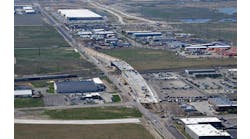By Don Di Zuzio and Peter Drinkwater, Contributing Authors
The remains of the old foundation of Hall’s Mill sits in a wooded area beside a creek in Freehold, N.J. The mill once stood at the northwest intersection of what is now Elton-Adelphia Road and the perpendicular Halls Mill Road.
For years, the townships of Freehold and Howell sought to improve Halls Mill Road with a realignment that would increase traffic circulation, relieve congestion, and — most importantly — enhance safety by reducing the risk of accidents. Although once serviceable, Halls Mill Road and Elton-Adelphia Road were too narrow to accommodate rising volumes of traffic. Other issues included sight-distance concerns and two bridges that had become functionally obsolete.
Managing the environmental impact, as well as minimizing any disturbance to sites of potential archaeological significance, complicated matters for Freehold, Howell, and Monmouth County, which took over the project. Monmouth County is home to thousands of acres of wetlands, some of which surround the various creeks and waterways that run along the road. Federally threatened species of wildlife, such as the bog turtle, live in the surrounding regions.
What started as a simple traffic congestion project broadened in scope. As the design engineer, T&M Associates was tasked with planning an ambitious, multi-million-dollar endeavor that would take several years. The project included realigning the geometry of more than a mile of roadway.
Other updates included the elimination of two adjacent ‘T’ intersections through the creation of a new four-way intersection; widening the roads to provide additional through and turn lanes; upgrades to the drainage collection system including two detention basins, an infiltration basin and a median bioswale for water quality treatment; creating ADA compatible pedestrian sidewalks and crossings; and replacing two outdated bridges. More than 30 parcels of land, encompassing about 17 acres, would need to be either acquired or have easements put in place to construct the improvements.
T&M Associates worked with the county to mitigate environmental impacts to this historic region. That The team understood that shifting the road away from environmentally sensitive features would potentially trigger additional considerations from the property-ownership perspective.
Five alternative roadway alignment proposals were created for review by the New Jersey Department of Environmental Protection (NJDEP) as part of the required Environmental Assessment mandated by the Federal National Environmental Policy Act (NEPA) process.
As Monmouth County worked to secure Federal Highway Administration funding in the early 2000s, extensive planning was under way. Monmouth County officials and T&M Associates attended meetings that with NJDEP and its Division of Land Resource Protection, the Green Acres Program, the Historic Preservation Office, the Bureau of Dam Safety and Flood Control, and the New Jersey Department of Transportation.
To balance out the necessity of filling a section of the floodplain to accommodate road widening and bridge construction, a plan was put in place to create additional flood storage by excavating more than 7,000 cubic yards of soil near one of the streams. The county also purchased wetland and riparian mitigation credits to further offset any environmental impact, preserving as many natural features of the landscape and waterways as possible.
Along the way, Monmouth County worked hard to keep the community as informed as possible. Residents understood that the planned improvements were necessary not only to improve traffic flows in the region, but to improve visibility and reduce the potential for accidents.
Sites of historical and cultural significance were examined and, if necessary, preserved. For thousands of years before the Halls Mill and Elton-Adelphia roadways existed, the Lenape people inhabited the region. Names like Lake Takanassee, Navesink River, and Manasquan are remnants of their culture, as are the tools, shells, and other artifacts left behind in their settlements.
The region was also the site of Revolutionary War activity. Numerous studies and surveys were conducted, which included surface inspection, remote sensing, and architectural testing. No sufficient evidence was found within the project area — the Area of Potential Effect (APE) — to suggest the presence of any sites eligible for inclusion on the National Register of Historic Places.
Studies and surveys conducted in 2006, 2016, and again in April 2020 — just before construction was finally set to commence — determined that the roadwork would pose no threat to the endangered bog turtle and its habitat.
The contractor broke ground on the roadway improvements in the Spring of 2020, with T&M Associates providing ongoing engineering support. Even as the COVID-19 pandemic brought much of the nation to a temporary standstill, essential building projects moved forward. Once the project was underway, construction progress was updated through variable message signs along the project roadway. Construction was staged to minimize disruption by always maintaining one lane of traffic in each direction through the work zone and utilizing a pedestrian bridge. More intrusive lane closures or full road closures with traffic detours were only permitted for one construction shift at a time and no long-term detours were allowed. The realignment along with other construction projects continued throughout 2021, and now, the $28 million project is in the process of wrapping up, right on schedule. The project has already garnered engineering excellence awards from the American Council of Engineering Companies of New Jersey and the NJ Alliance for Action.
It was a long journey to get us to this point, but with a rewarding outcome that is enhancing the community, improving commutes for workers, and potentially saving lives. We encourage municipalities with similar aspirations to carefully consider the environmental ramifications, not only as a legal obligation but also out of a responsibility to conserve natural resources for future generations. Plan carefully and involve the community and all stakeholders as early as possible. The results are well worth the time and effort. R&B
Don Di Zuzio, Senior VP and Transportation Practice Leader, and Peter Drinkwater, Transportation Department Manager, are with T&M Associates, a leading national consulting, environmental, engineering, technical services, and construction management company.



